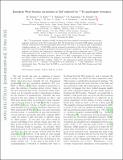Emergent Weyl fermion excitations in TaP explored by 181Ta quadrupole resonance
Abstract
The 181Ta quadrupole resonance [nuclear quadrupole resonance (NQR)] technique is utilized to investigate the microscopic magnetic properties of the Weyl semimetal TaP. We find three zero-field NQR signals associated with the transition between the quadrupole split levels for Ta with I=7/2 nuclear spin. A quadrupole coupling constant, νQ=19.250 MHz, and an asymmetric parameter of the electric field gradient, η=0.423, are extracted, in good agreement with band structure calculations. In order to examine the magnetic excitations, the temperature dependence of the spin-lattice relaxation rate (1/T1T) is measured for the f2 line (±5/2↔±3/2 transition). We find that there exist two regimes with quite different relaxation processes. Above T∗≈30 K, a pronounced (1/T1T) α T2 behavior is found, which is attributed to the magnetic excitations at the Weyl nodes with temperature-dependent orbital hyperfine coupling. Below T∗, the relaxation is mainly governed by a Korringa process with 1/T1T=const, accompanied by an additional T-1/2-type dependence to fit our experimental data. We show that Ta NQR is a novel probe for the bulk Weyl fermions and their excitations.
Citation
Yasuoka , H , Kubo , T , Kishimoto , Y , Kasinathan , D , Schmidt , M , Yan , B , Zhang , Y , Tou , H , Felser , C , Mackenzie , A P & Baenitz , M 2017 , ' Emergent Weyl fermion excitations in TaP explored by 181 Ta quadrupole resonance ' , Physical Review Letters , vol. 118 , no. 23 , 236403 . https://doi.org/10.1103/PhysRevLett.118.236403
Publication
Physical Review Letters
Status
Peer reviewed
ISSN
0031-9007Type
Journal article
Description
T. K., Y. K., and H. T. appreciate the financial support from JSPS KAKENHI Grants (No. 15K21732 and No. 15H05885). D. K. acknowledges funding via FOR 1346 from the Deutsche Forschungsgemeinschaft.Collections
Items in the St Andrews Research Repository are protected by copyright, with all rights reserved, unless otherwise indicated.

